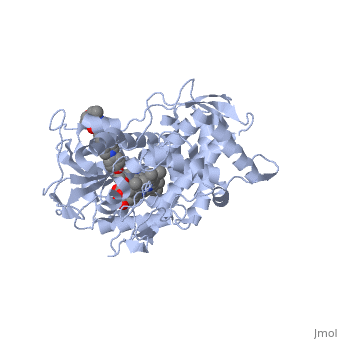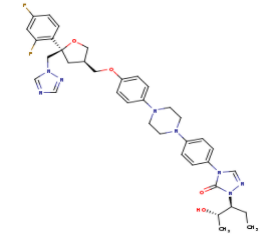Sandbox 123456
From Proteopedia
(Difference between revisions)
| Line 24: | Line 24: | ||
== Relevance == | == Relevance == | ||
| - | Invasive fungal infections, commonly caused by "Candida" or "Aspergillus" species affect patients that are immunocompromised such as those with different pre-existing infections or more seriously for those with immunologically suppressing diseases like HIV/AIDS. "Candida" (thrush/Candidiasis) is the most common yeast pathogen that typically grows in human mucosal surfaces like the intestinal tract and causes pathology when it becomes overgrown. "Aspergillus" is the most common mold pathogen leading to invasive fungal infections, termed Aspergillosis, when it is acquired from the surrounding environment <ref name="soysal">doi: 10.2147/IDR.S65592</ref>. Noxafil oral suspension is the best form of treatment for invasive Candida and Aspergillus infections in patients 13 years and older who are severely immunocompromised. Noxafil is also more effective at preventing invasive fungal infections in immunocompromised patients when compared to other antifungal treatments (fluconazole and itraconazole)<ref name="dekkers">doi: 10.1007/s12281-016-0255-4</ref> . Overall, Noxafil displays fewer cases of invasive fungal infections and is also a more affordable treatment for immunocompromised patients. (Add more & add citations). There has been a noticeable increase in the incidence of invasive fungal infections particularly within patients receiving chemotherapy and transplant recipients. These patients are extremely susceptible because of their compromised immune system and the pressures from antibiotic usage, which is why invasive fungal infections are on the rise with these medical advances <ref name | + | Invasive fungal infections, commonly caused by "Candida" or "Aspergillus" species affect patients that are immunocompromised such as those with different pre-existing infections or more seriously for those with immunologically suppressing diseases like HIV/AIDS. "Candida" (thrush/Candidiasis) is the most common yeast pathogen that typically grows in human mucosal surfaces like the intestinal tract and causes pathology when it becomes overgrown. "Aspergillus" is the most common mold pathogen leading to invasive fungal infections, termed Aspergillosis, when it is acquired from the surrounding environment <ref name="soysal">doi: 10.2147/IDR.S65592</ref>. Noxafil oral suspension is the best form of treatment for invasive Candida and Aspergillus infections in patients 13 years and older who are severely immunocompromised. Noxafil is also more effective at preventing invasive fungal infections in immunocompromised patients when compared to other antifungal treatments (fluconazole and itraconazole)<ref name="dekkers">doi: 10.1007/s12281-016-0255-4</ref> . Overall, Noxafil displays fewer cases of invasive fungal infections and is also a more affordable treatment for immunocompromised patients. (Add more & add citations). There has been a noticeable increase in the incidence of invasive fungal infections particularly within patients receiving chemotherapy and transplant recipients. These patients are extremely susceptible because of their compromised immune system and the pressures from antibiotic usage, which is why invasive fungal infections are on the rise with these medical advances <ref name= "dekkers"/>. |
== References == | == References == | ||
<references/> | <references/> | ||
Revision as of 21:22, 19 April 2017
| |||||||||||


